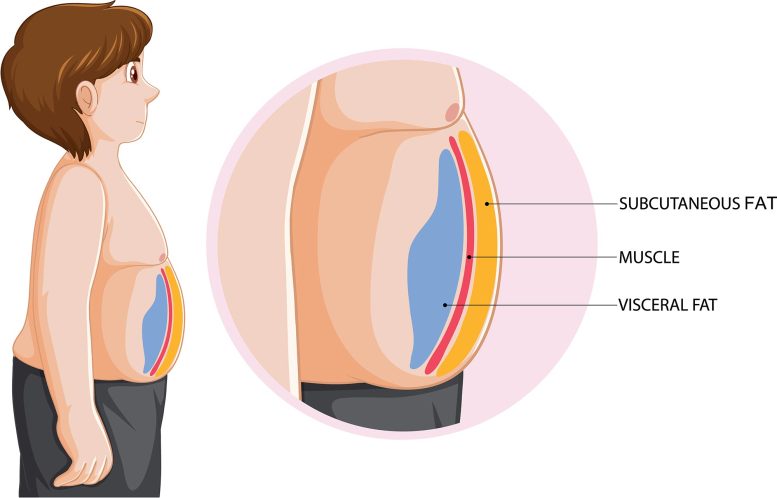
Visceral fat, often referred to as ‘hidden’ fat, is stored deep within the belly, wrapping around vital organs. Despite only constituting about a tenth of the body’s total fat on average, it’s significantly more hazardous than subcutaneous fat due to its toxic hormone production.
Visceral body fat, frequently referred to as the ‘hidden’ fat, is a type of fat that accumulates deep within the belly and encases our vital organs such as the liver and intestines. On average, it constitutes about a tenth of all the fat stored within the human body. This invisible fat is far more dangerous compared to the more visible, subcutaneous fat which lies beneath the skin and can be easily felt. Why is it more dangerous, you might wonder? The answer lies in the harmful chemicals and hormones that visceral fat generates, which can be toxic to our bodies.
This unseen enemy, which typically gives a person an ‘apple’ shape, is more prevalent in men than in women. It’s important to realize that even slender individuals aren’t exempt from the dangers posed by visceral fat, emphasizing the fact that physical appearance isn’t a reliable indicator of visceral fat presence.
So, what are the main factors leading to visceral fat? Predominantly, a sedentary lifestyle paired with excessive calorie intake can result in fat storage. Genetics also play a role, predisposing certain individuals to accumulate fat in the abdominal region instead of the hips. As women age and undergo menopause, a shift in fat storage is observed, leading to an increase in visceral fat despite maintaining the same weight. In men, factors such as age, genetics, and alcohol consumption contribute to the accumulation of visceral fat.

Visceral fat and subcutaneous fat differ primarily in terms of their location in the body and the health risks they pose. Subcutaneous fat is located directly under the skin and is often responsible for changes in body shape and size. This type of fat can be pinched or felt and is distributed across the body, most notably in areas like the thighs, arms, and abdomen. While it does play a role in conditions like obesity, it generally poses fewer health risks than visceral fat. On the other hand, visceral fat is stored deeper within the body, surrounding vital organs like the liver, intestines, and heart. Although it is less visible and cannot be easily felt, visceral fat is far more dangerous due to the toxic substances it produces, increasing the risk of serious health conditions like heart disease, type 2 diabetes, stroke, and certain types of cancer.
Understanding the health risks associated with visceral fat is crucial. Visceral fat is a precursor to metabolic syndrome, a cluster of conditions including high blood pressure, obesity, high cholesterol, and insulin resistance. These conditions, in combination, heighten the risk of serious health complications like stroke, heart disease, and type 2 diabetes. But the dangers don’t stop there. Excessive visceral fat is also linked with dementia, cancer, asthma, liver and gall bladder diseases, fertility issues, lower back pain, and osteoarthritis.
So, how can you tell if you’re harboring this potentially harmful visceral fat? The most reliable indicator is your waist circumference. If a woman’s waist measurement exceeds 32 inches, or a man’s 37 inches, they are at an increased risk of chronic disease due to visceral fat. However, these measurements don’t apply to pregnant women or children. The Body Mass Index (BMI) can also provide insights into whether you are carrying an excess of fat. If you suspect that your waist measurement may be too large, it is advisable to consult your doctor.
Now, onto the crucial part — how can visceral fat be reduced? Weight loss through a healthy diet and regular physical activity is the most effective method. In fact, visceral fat tends to respond better to diet and exercise than fat on the hips. Sustained exercise can prevent the recurrence of visceral fat. Medication is another alternative but studies suggest that it’s not as effective as exercise in eliminating visceral fat. Moreover, liposuction is ineffective in removing visceral fat.
While it’s true that we can’t alter our genetic makeup, hormones, or age, there are several lifestyle changes we can make to mitigate the risk of disease caused by visceral fat. These include:
- Engaging in at least 30 minutes of physical activity every day. This could be brisk walking, cycling, aerobic exercises, or strength training.
- Consuming a nutritious, balanced diet.
- Avoiding smoking.
- Minimizing the intake of sugary beverages.
- Ensuring adequate sleep.
Remember, visceral fat is not just about appearances — it’s about maintaining a healthy, active lifestyle for overall well-being. By following the recommendations listed, you can reduce visceral fat and improve your health and longevity.

